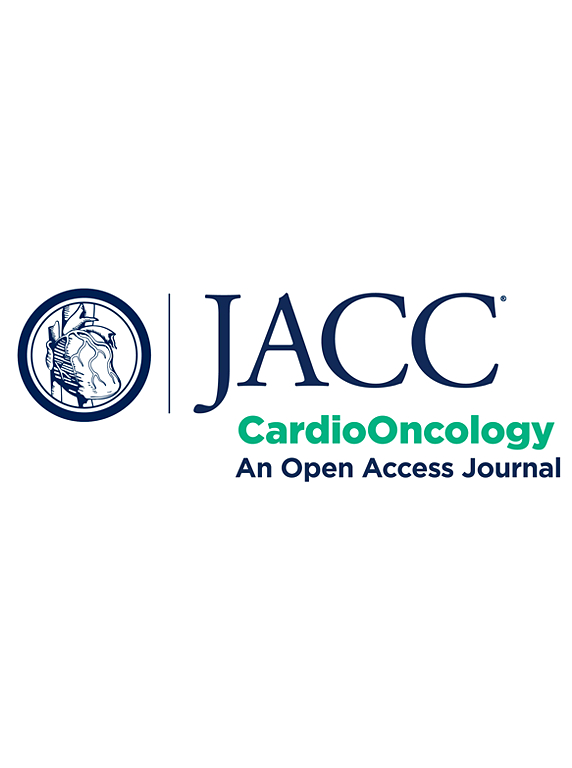her2靶向治疗期间降低心脏毒性监测的心脏安全性
IF 12.8
1区 医学
Q1 CARDIAC & CARDIOVASCULAR SYSTEMS
引用次数: 0
摘要
背景:在接受her2靶向治疗的患者中,尽管越来越多地使用与低CTRCD风险相关的更安全的方案,但建议每3个月进行一次超声心动图检查,以监测癌症治疗相关的心功能障碍(CTRCD)。目的:本研究评估在非蒽环类her2靶向治疗期间每6个月进行一次降低CTRCD监测的心脏安全性。方法本非随机临床试验纳入190例her2阳性乳腺癌患者,接受非蒽环类her2靶向治疗。超声心动图监测CTRCD每6个月一次。主要的排除标准是既往的蒽环类药物暴露、明显的心血管疾病和未控制的高血压。主要终点是心脏事件发生率,定义为心力衰竭或心血管死亡1年。次要结局包括LVEF从基线到6个月和1年的变化,无症状CTRCD的发生率,her2靶向治疗中断的发生率,以及降低心脏监测的可行性。结果中位年龄52岁(Q1-Q3: 45-60岁);174例(91.6%)为I-III期疾病,所有患者均接受基于曲妥珠单抗的治疗方案。心血管危险因素包括高血压(20.0%)和糖尿病(4.2%),基线时平均左室射血分数为63.6±SE 0.3%。0 (0%;单侧97.5% CI: 0%-1.9%),中位随访时间为17.5个月(Q1-Q3: 16.3-18.9个月)。1例患者出现无症状CTRCD (0.5%;95% CI: 0.01%-2.9%),但在短暂治疗中断后恢复治疗。每6个月减少CTRCD监测计划的依从性为73.2%(意向治疗)和79.9%(每个方案)。结论减少每6个月的CTRCD监测对低风险CTRCD患者是安全可行的,可能是在非蒽环类her2靶向治疗方案中考虑的适当策略。本文章由计算机程序翻译,如有差异,请以英文原文为准。
Cardiac Safety of Reduced Cardiotoxicity Surveillance During HER2-Targeted Therapy
Background
Echocardiograms are recommended every 3 months to monitor for cancer therapy–related cardiac dysfunction (CTRCD) among patients treated with HER2-targeted therapy, despite increasing use of safer regimens associated with low CTRCD risk.
Objectives
This study evaluated the cardiac safety of reduced CTRCD surveillance performed every 6 months during non-anthracycline HER2-targeted treatment.
Methods
This non-randomized clinical trial enrolled 190 patients with HER2-positive breast cancer treated with non-anthracycline HER2-targeted therapy. CTRCD surveillance by means of echocardiography was performed every 6 months. Key exclusion criteria were previous anthracycline exposure, significant cardiovascular disease, and uncontrolled hypertension. The primary outcome was the cardiac event rate, defined by heart failure or cardiovascular death at 1 year. Secondary outcomes included change in LVEF from baseline to 6 months and 1 year, incidence of asymptomatic CTRCD, incidence of HER2-targeted treatment interruption, and feasibility of reduced cardiac surveillance.
Results
The median age was 52 years (Q1-Q3: 45-60 years); 174 (91.6%) had stage I-III disease, and all were treated with a trastuzumab-based regimen. Cardiovascular risk factors included hypertension (20.0%) and diabetes (4.2%), and the mean left ventricular ejection fraction at baseline was 63.6 ± SE 0.3%. There were 0 (0%; 1-sided 97.5% CI: 0%-1.9%) cardiac events with a median follow-up of 17.5 months (Q1-Q3: 16.3-18.9 months). One patient developed asymptomatic CTRCD (0.5%; 95% CI: 0.01%-2.9%) but resumed therapy after a temporary treatment interruption. Adherence to the reduced CTRCD surveillance schedule every 6 months was 73.2% (intention-to-treat) and 79.9% (per-protocol).
Conclusions
Reduced CTRCD surveillance every 6 months is safe and feasible for patients at low risk for CTRCD and may be an appropriate strategy to consider during non-anthracycline HER2-targeted treatment regimens.
求助全文
通过发布文献求助,成功后即可免费获取论文全文。
去求助
来源期刊

Jacc: Cardiooncology
Multiple-
CiteScore
12.50
自引率
6.30%
发文量
106
期刊介绍:
JACC: CardioOncology is a specialized journal that belongs to the esteemed Journal of the American College of Cardiology (JACC) family. Its purpose is to enhance cardiovascular care for cancer patients by publishing high-quality, innovative scientific research and sharing evidence-based knowledge.
The journal aims to revolutionize the field of cardio-oncology and actively involve and educate professionals in both cardiovascular and oncology fields. It covers a wide range of topics including pre-clinical, translational, and clinical research, as well as best practices in cardio-oncology. Key areas of focus include understanding disease mechanisms, utilizing in vitro and in vivo models, exploring novel and traditional therapeutics (across Phase I-IV trials), studying epidemiology, employing precision medicine, and investigating primary and secondary prevention.
Amyloidosis, cardiovascular risk factors, heart failure, and vascular disease are some examples of the disease states that are of particular interest to the journal. However, it welcomes research on other relevant conditions as well.
 求助内容:
求助内容: 应助结果提醒方式:
应助结果提醒方式:


